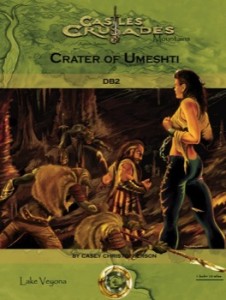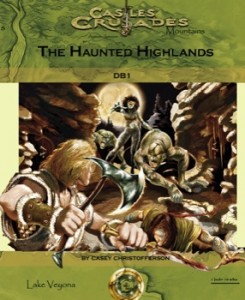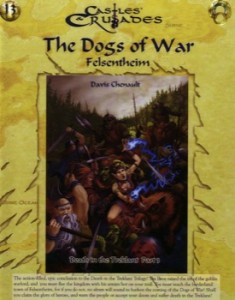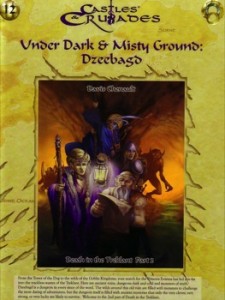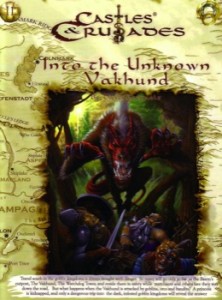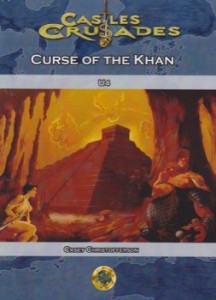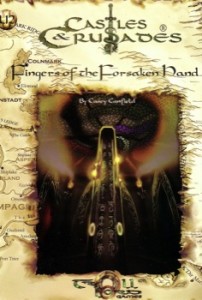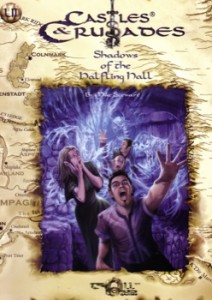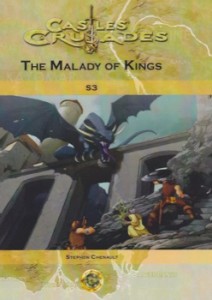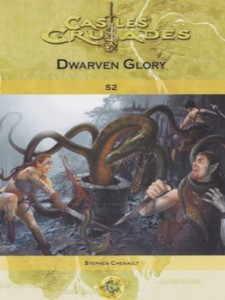This is a Castles & Crusades adventure although it can easily be used with an pre-4E version of D&D.
This is a three-level dungeon, further levels are show in the next module in the series, that is a kobold hack-fest. It’s rather one-dimensional, in a semi-interesting location, and expands in to a undead filled lower level.
From time to time I like to offer advice to to the rulers of fantasy kingdoms and I’d like to take this opportunity to do that once again. Time and time again we see proud and storied civilizations destroyed by the gods. It’s time to learn from history kids: spread the love around a bit. If your civilization is at the height of it’s power then don’t go around breaking some young gods heart. It’s not going to end well. I t never does.
This adventure revolves around the Create of Umeshti. In days long past it was a shining city, until a giant rock was dropped on it by some jealous gods. Lunar based mass drivers: Effective and Green! A bit later some dwarves tunneled in and mined all the special iron. When the ore ran out they left and … other creatures moved in. Seriously? How many times have we seen this? Someone needs to start riding those little bearded boogers about this type of behavior. It’s like libertarians on midwest coal plants: yeah, it’s not hurting anyone right now, but what happens later when the frigging Balrog moves in? How many mountaintops have the dwarves removed in order to get at that precious ore? Do they clean up later? On nooooooo, of course not, there’s no funds left for that after they get slaughtered.
In this case we have a multi-level dungeon centered around a great crater in the earth. This product presents the exterior of the crater as well as the first three levels. The next module in the series appears to expand the crater with more levels. The primary tunnels in the levels were created by the dwarves before they left the complex, with some expansion by the current residents. The exterior of the crater is inhabited by kobolds; there are “dozens of caves” where they hide out and harass the party, and provide warning to the first level of the crater. The first two levels are full of kobolds as well.
The maps are relatively simple. There’s a central pit/shaft surrounded by worked dwarven tunnels and chambers. On the first two levels there are also some supplemental tunnels, kobold sized, that link some of the chambers. Access between the various levels is by an indestructible dwarven lift basket system. Generally access between two levels is on one side of the pit and access to the next level is on the other side, requiring that at least half the level be explored to get to the next level. I don’t usually complain or note layout unless there’s something very troubling. There is in this. The maps are presented as TINY. They take up about 1/3 of one column on a page. My tired old eyes need to bring the book up very close and squint to get the detail. Uncool. The basic layout is linear, in a circle around the central pit.
The first two levels are crawling with kobolds. Just about every room has some and it’s very probable that the PC’s will be attacked from the moment they get in the basket and descend. There are not really many tricks/traps, just one or two. The most interesting is a “don’t desecrate my temple” type of encounter. The best way to describe this is a as a relatively realistic monster lair. A couple of vermin, but mostly just kobolds, with a few traps and without any weird elements. The third level is the home to a necromancer. The map layout is mostly the same, a linear map in a circle shape. Again, mostly just a hack-fest with undead and tougher than normal kobolds. There are no really interesting elements.
It looks like this module is trying to be a megadungeon. Multiple levels, increasing difficulty between levels, and a page or so on how to restock the dungeon between adventurer forays all contribute to that feeling. It’s a little too crowded for my megadungeon tastes, and needs some more interesting maps so we get more of an exploration feel and less of a hack-fest feel. I don’t have a problem with a group slaughtering kobolds, however I would have preferred to see some additional notes on how the kobolds would respond. There’s a just a few brief sentences and they don’t really cover a coordinated response by the kobolds.
If I were to run this, and I may as a Meetup game, I would probably run it it in one of two ways. Given that there are nearly 100 kobolds on the first level, and they mostly have 2 HP each, I may run it as a dark comical adventure. DEX checks for slipping on entrails, buckets of blood from slaughtered kobolds EVERYWHERE, kobold eyes hanging off of swords, just a really ridiculous amount of gore, with the implicit, but not explicit, moral implications for the PC’s. The other way would be to make the kobolds some pretty heavy hit & run snipers with their missile weapons, making raids on the party and never staying anywhere to fight toe to toe. It would lend itself nicely to the first style of play, and maybe not so well to the second, just because of the sheer numbers of kobolds involved. Although, the chaos of a running battle, PC’s splitting up, and so on, would be very interesting to see as well.
This is available on DriveThru.

